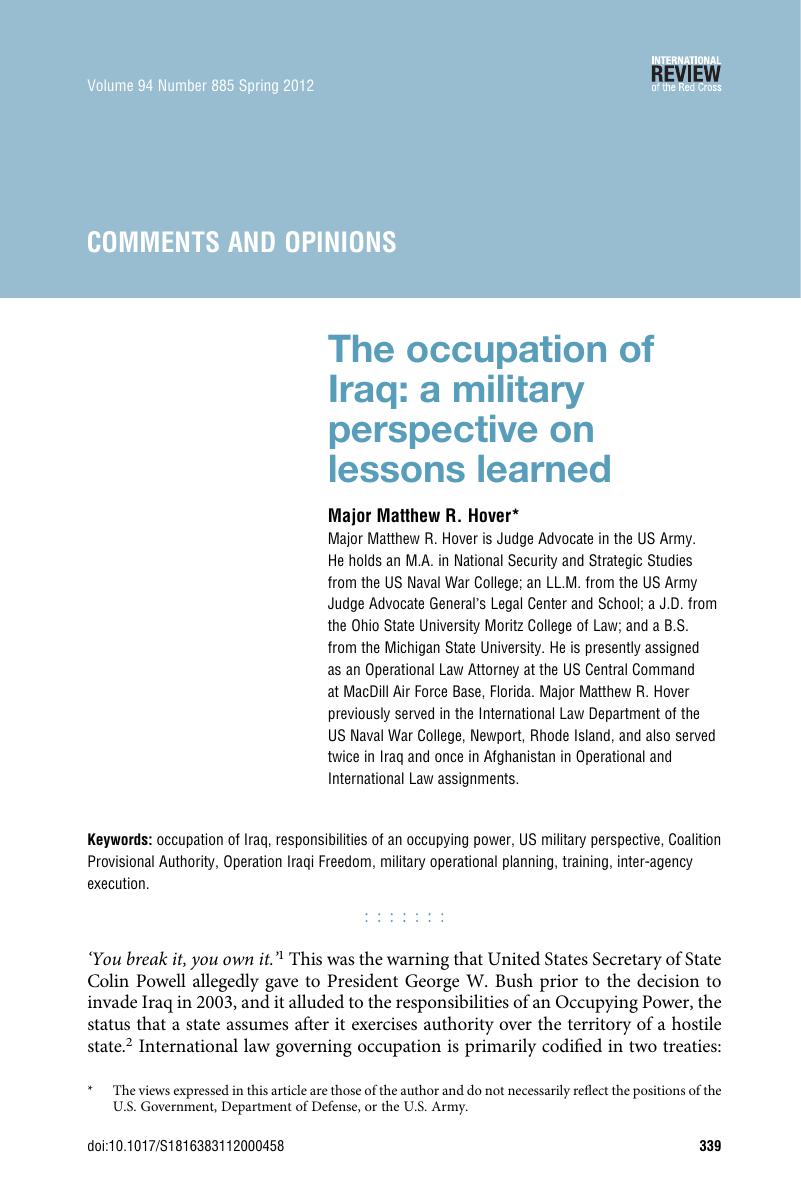Article contents
The occupation of Iraq: a military perspective on lessons learned
Published online by Cambridge University Press: 17 October 2012
Abstract

Keywords
Information
- Type
- Comments and Opinions
- Information
- International Review of the Red Cross , Volume 94 , Issue 885: Occupation , March 2012 , pp. 339 - 346
- Copyright
- Copyright © International Committee of the Red Cross 2012
Footnotes
The views expressed in this article are those of the author and do not necessarily reflect the positions of the U.S. Government, Department of Defense, or the U.S. Army.
References
1 Woodward, Bob, Plan of Attack, Simon and Schuster, New York, 2004, p. 150Google Scholar.
2 Hague Convention (IV) Respecting the Laws and Customs of War on Land and its Annex: Regulations. Concerning the Laws and Customs of War on Land, 18 October 1907 (hereafter Hague Regulations), Art. 42.
3 Joint Chiefs of Staff, Joint Publication 5–0, Joint Operation Planning, 11 August 2011, Chapter III, Section C (hereafter Joint Pub. 5–0). See also Joint Chiefs of Staff, Joint Publication 3–07, Stability Operations, 29 September 2011, p. III–4 (hereafter Joint Pub. 3–07).
4 See generally Joint Pub. 5–0, above note 3, Chapter II.
5 Paul Wolfowitz, interview with Melissa Block (National Public Radio), 19 February 2003, available at: http://www.defense.gov/transcripts/transcript.aspx?transcriptid=1937 (last visited February 2012).
6 Ricks, Thomas E., Fiasco: The American Military Adventure in Iraq, Penguin Press, New York, 2006, pp. 95–97Google Scholar.
7 Anthony Cordesman, interview with PBS for ‘The Lost Year in Iraq’, available at: http://www.pbs.org/wgbh/pages/frontline/yeariniraq/interviews/cordesman.html (last visited February 2012). Cordesman is an expert in Middle East and national defense policy at the Center for Strategic and International Studies.
8 Oliver, George F., Rebuilding Germany after World War II, Naval War College 3040, 2008, pp. 4–19Google Scholar, article on file with the author.
9 An operation plan (OPLAN) is ‘any plan for the conduct of military operations prepared in response to actual and potential contingencies’. This level of advanced planning is typically reserved for a contingency that is critical to national security; in addition to explaining the concept of operations, the plan also specifies the forces, functional support, and resources required to execute it. See Joint Pub. 5–0, above note 3, p. II–24.
10 G. F. Oliver, above note 8, pp. 15–30.
11 ‘Third Infantry Division (Mechanized) After Action Report: Operation IRAQI FREEDOM’, 2003, available at: http://www.globalsecurity.org/military/library/report/2003/3id-aar-jul03.pdf (last visited February 2012), pp. 18 and 281.
12 Broadly speaking, civil–military operations focus on immediate or near-term issues such as health service infrastructure; movement, feeding, and sheltering of dislocated civilians; police and security programmes; building host-nation government legitimacy; synchronization of civil–military operations support to tactical commanders; and the co-ordination, synchronization, and, where possible, integration of inter-agency, intergovernmental organization, and non-governmental organization activities with military operations. Joint Chiefs of Staff, Joint Publication 3–57, Civil-Military Operations, 8 July 2008, Chapter I, p. I–5.
13 T. E. Ricks, above note 6, p. 152.
14 Ibid., p. 150.
15 Center for Law and Military Operations, Forged in the Fire: Legal Lessons Learned During Military Operations 1994–2008, The Judge Advocate General's Legal Center and School, September 2008, (hereafter Forged in the Fire), pp. 12–16.
16 Center for Law and Military Operations, Lessons Learned from Afghanistan and Iraq, Volume II: Full Spectrum Operations (2 May 2003–30 June 2004), The Judge Advocate General's Legal Center and School, 2005, pp. 20–21.
17 Forged in the Fire, above note 15, p. 14, n. 39.
18 T. E. Ricks, above note 6, p. 132.
19 Antulio J. Echevarria II, Toward an American Way of War, US Army War College Strategic Studies Institute, March 2004, available at: http://www.strategicstudiesinstitute.army.mil/pubs/display.cfm?pubID=374 (last visited February 2012).
20 T. E. Ricks, above note 6, p. 204.
21 G. F. Oliver, above note 8, p. 3.
22 Ibid., pp. 5–8.
23 The White House, ‘National Security Presidential Directive/NSPD-44’, Washington DC, 7 December 2005, available at: http://www.fas.org/irp/offdocs/nspd/nspd-44.html (last visited February 2012).
24 Szayna, Thomas S., Eaton, Derek, and Richardson, Amy, Preparing the Army for Stability Operations: Doctrinal and Interagency Issues, RAND Corporation, Santa Monica, CA, 2007, p. 8Google Scholar.
25 Joint Pub. 3–07, p. I–2.
26 Ibid., p. I–1.
27 Provincial reconstruction teams were ‘relatively small operational units comprised not just of diplomats, but military officers, development policy experts (from the U.S. Agency for International Development, the Department of Agriculture, and the Department of Justice), and other specialists (in fields such as rule of law, engineering, and oil industry operations) who work[ed] closely with Iraqi provincial leaders and the Iraqi communities that they serve[d]. While PRTs dispense[d] money for reconstruction projects, the strategic purpose of these civil–military field teams [was] both political and economic’. US Department of State, ‘Provincial Reconstruction Teams’, available at: http://www.state.gov/p/nea/ci/iz/c21830.htm (last visited February 2012).
- 2
- Cited by

